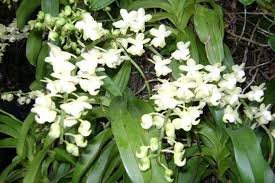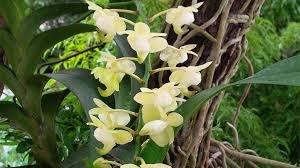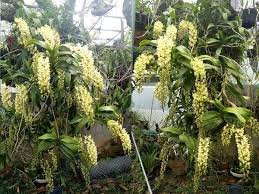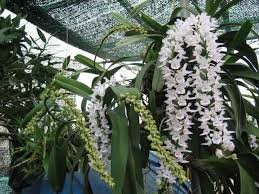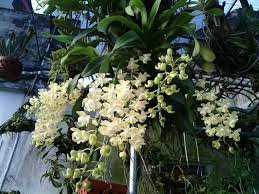Nov 4, 2024
# Quế Lan Hương (Dendrobium anosmum) and Popular Hybrid Varieties
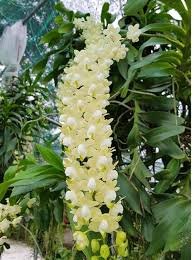
Quế Lan Hương, scientifically known as *Dendrobium anosmum*, is a stunning orchid native to Southeast Asia, especially Vietnam. Renowned for its fragrant flowers and striking beauty, this species has captured the hearts of many orchid enthusiasts and collectors. Beyond its natural form, *Quế Lan Hương* has also given rise to numerous hybrid varieties, each boasting unique characteristics and adaptations. In this comprehensive article, we will explore the features of *Quế Lan Hương*, delve into the various popular hybrids, and discuss their care and cultivation.
## 1. Introduction to Quế Lan Hương
### A. Characteristics of Quế Lan Hương
*Quế Lan Hương* is known for its beautiful, pendulous flower spikes, which can reach lengths of up to 20 inches. The flowers are typically fragrant and can be found in various colors, including shades of purple, white, and pink. Here are some notable characteristics:
– **Growth Habit**: This orchid is an epiphyte, meaning it naturally grows on trees in its native habitat, attaching itself to branches and trunks. Its growth habit is characterized by long, slender pseudobulbs that can reach several inches in length.
– **Leaves**: The leaves of *Quế Lan Hương* are green, leathery, and typically ovate in shape. They grow in clusters around the pseudobulbs, contributing to the plant’s lush appearance.
– **Blooming Season**: The flowering season for *Quế Lan Hương* generally occurs in late winter to early spring. During this time, the orchid produces spectacular blooms that can last for several weeks.
### B. Cultural Significance
In Vietnamese culture, *Quế Lan Hương* holds a special place. Its flowers are often associated with beauty, love, and harmony. They are commonly used in traditional celebrations and ceremonies, symbolizing prosperity and good fortune.
## 2. The Rise of Hybridization
Hybridization in orchids involves crossing two different species or varieties to create a new plant with desirable traits. The popularity of hybrid orchids has soared in recent years due to their unique appearances and improved characteristics. Here’s why hybridization is significant:
### A. Enhancing Traits
1. **Fragrance**: Many hybrids retain the delightful fragrance of *Quế Lan Hương*, making them even more appealing to growers.
2. **Flower Color**: Hybridization allows for a wider range of colors and patterns than those found in the species alone. This diversity attracts collectors and enthusiasts alike.
3. **Growth Habits**: Hybrids are often bred for improved growth habits, such as shorter or more compact forms, making them suitable for indoor cultivation.
### B. Popular Hybrid Varieties of Quế Lan Hương
Several hybrids have emerged from the crossing of *Quế Lan Hương* with other *Dendrobium* species or hybrids. Here, we explore some of the most popular hybrids:
#### 1. Dendrobium ‘Big Shot’
– **Parentage**: This hybrid is a cross between *Dendrobium anosmum* and *Dendrobium aggregatum*.
– **Features**: The flowers are larger than those of the species and come in shades of purple and white. They are known for their vibrant colors and strong fragrance.
– **Cultivation**: Dendrobium ‘Big Shot’ thrives in bright, indirect light and requires moderate humidity levels. It is suitable for both indoor and outdoor cultivation.
#### 2. Dendrobium ‘Spring Dream’
– **Parentage**: This hybrid results from crossing *Dendrobium anosmum* with *Dendrobium nobile*.
– **Features**: Known for its striking pastel colors, *Spring Dream* produces clusters of blooms that exude a sweet fragrance. The flowers typically have a unique pattern, with shades of pink and lavender.
– **Cultivation**: It requires similar care to its parent species, preferring bright light and regular watering during the growing season.
#### 3. Dendrobium ‘Fragrant Breeze’
– **Parentage**: A hybrid of *Dendrobium anosmum* and *Dendrobium phalaenopsis*.
– **Features**: This variety is celebrated for its large, fragrant flowers that feature a mix of colors, including white, yellow, and pink. The plant produces abundant blooms that create a stunning display.
– **Cultivation**: It enjoys bright, filtered light and should be kept in a humid environment to thrive.
#### 4. Dendrobium ‘Rainbow Delight’
– **Parentage**: A cross between *Dendrobium anosmum* and *Dendrobium kingianum*.
– **Features**: This hybrid boasts a rainbow of colors, including vibrant yellows, pinks, and purples. The flowers are smaller but are produced in abundance, creating a colorful display.
– **Cultivation**: *Rainbow Delight* is relatively easy to care for and prefers bright light and a well-draining potting medium.
## 3. Cultivation and Care of Quế Lan Hương and Its Hybrids
### A. Growing Conditions
Regardless of whether you are cultivating the species or hybrids, providing the right growing conditions is crucial for success. Here are some key factors to consider:
#### 1. Light Requirements
– **Optimal Light Levels**: All *Dendrobium* orchids, including *Quế Lan Hương* and its hybrids, prefer bright, indirect light. Direct sunlight can scorch the leaves, while too little light can hinder blooming.
– **Supplemental Lighting**: If growing indoors, consider using grow lights to provide sufficient light, especially during the shorter days of winter.
#### 2. Temperature Preferences
– **Ideal Temperature Range**: These orchids thrive in temperatures between 60°F and 85°F (16°C to 29°C). They can tolerate brief drops to around 50°F (10°C) during the night but should be protected from frost.
– **Seasonal Variations**: Temperature fluctuations between day and night can help stimulate flowering.
#### 3. Humidity and Air Circulation
– **Humidity Levels**: *Quế Lan Hương* and its hybrids prefer high humidity levels, ideally between 50% and 70%. In drier conditions, consider using humidity trays or misting the plants.
– **Air Circulation**: Good air circulation is essential to prevent fungal infections. Ensure proper spacing between plants and consider using fans if growing indoors.
### B. Watering Practices
Proper watering techniques are critical for the health of *Quế Lan Hương* and its hybrids:
– **Watering Schedule**: Water when the top inch of the potting medium feels dry. Overwatering can lead to root rot, while underwatering can stress the plant.
– **Water Quality**: Rainwater or distilled water is preferred, as tap water may contain chemicals that can harm the orchids.
### C. Fertilization Techniques
1. **Fertilizer Choice**: Use a balanced orchid fertilizer, typically high in phosphorus to encourage blooming.
2. **Feeding Schedule**: Fertilize every two weeks during the growing season and reduce to once a month during dormancy.
## 4. Common Pests and Diseases
Like all orchids, *Quế Lan Hương* and its hybrids can be susceptible to pests and diseases. Awareness and proactive care can help mitigate these issues:
### A. Common Pests
1. **Aphids**: Small, sap-sucking insects that can weaken the plant. Control with insecticidal soap or neem oil.
2. **Mealybugs**: These pests appear as white, cottony masses and can be controlled using similar methods as aphids.
3. **Spider Mites**: Tiny pests that thrive in low humidity. Increase humidity and use insecticidal soap for control.
### B. Diseases
1. **Root Rot**: Caused by overwatering or poorly draining potting media. Ensure proper drainage and allow the medium to dry between waterings.
2. **Leaf Spot**: Often a result of overwatering or humidity issues. Improve air circulation and avoid water on the leaves.
## 5. Conclusion
*Quế Lan Hương* and its hybrids are not only beautiful but also offer a range of desirable traits that make them popular among orchid enthusiasts. By understanding the characteristics of this orchid, exploring the various hybrids, and providing proper care, growers can enjoy vibrant blooms and the delightful fragrance that these plants bring. Whether you are an experienced collector or a beginner, *Quế Lan Hương* and its hybrids can be a rewarding addition to your orchid collection, providing joy and beauty for years to come. Happy growing!
More Details